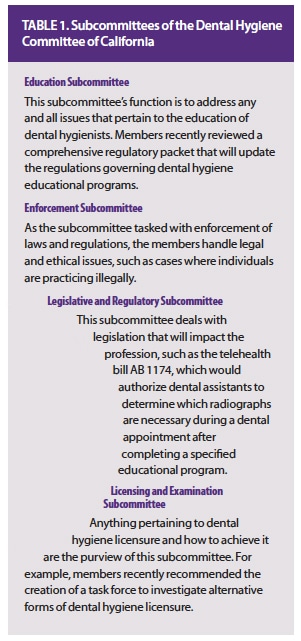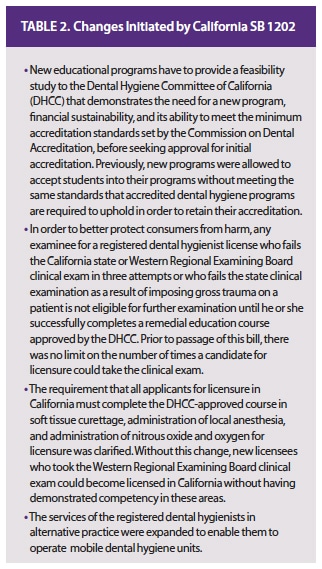
Shaping the Future of Dental Hygiene Practice
Self-regulation is key to ensuring the health and longevity of the dental hygiene profession.
In order for a vocation to be considered a “profession,” it must be self-regulated. When I graduated from dental hygiene school in 1986, I had no idea that dental hygiene did not meet this requirement. And I was unaware of how impactful the absence of self-regulation would be on my daily life as a practicing dental hygienist. I didn’t truly understand the importance of dental hygienists controlling their licensure and education, as well as regulating the activities of licensed practitioners until I began working as a liaison to the California State Board of Dental Examiners (now called the Dental Board of California). The ability of dental hygienists to govern their profession is critical to its success and longevity. Unfortunately, California is the only state in the country that allows self-regulation for dental hygienists through the Dental Hygiene Committee of California (DHCC).
 Created in January 2010, the DHCC is responsible for licensing and enforcing three categories of dental hygienists practicing in California: registered dental hygienists; registered dental hygienists in alternative practice (RDHAP); and registered dental hygienists in extended functions (RDHEF). The DHCC develops and administers written and clinical licensing examinations, conducts occupational analyses of the various professional categories, oversees enforcement, and evaluates educational courses and programs. The DHCC also participates in outreach and support of the dental and dental hygiene communities with the
Created in January 2010, the DHCC is responsible for licensing and enforcing three categories of dental hygienists practicing in California: registered dental hygienists; registered dental hygienists in alternative practice (RDHAP); and registered dental hygienists in extended functions (RDHEF). The DHCC develops and administers written and clinical licensing examinations, conducts occupational analyses of the various professional categories, oversees enforcement, and evaluates educational courses and programs. The DHCC also participates in outreach and support of the dental and dental hygiene communities with the  goal of ensuring high-quality oral health care for all Californians.
goal of ensuring high-quality oral health care for all Californians.
Prior to the inception of the DHCC, the profession of dental hygiene was regulated by the Dental Board of California, which comprises one dental hygienist, one dental assistant, five public members, and seven dentists. As dentists make up the majority of the board, the needs of the dental hygiene profession and the consumers seeking access to dental hygiene services were often overlooked. The DHCC consists of four dental hygienists, four public members, and one practicing dentist. All members are appointed by the governor of California. The function of the committee is to hear public comment and act upon any programmatic, legislative, or other issue(s) that may affect the dental hygiene profession, interested stakeholders, and, most importantly, the consumers of California.
The DHCC’s structure includes education, enforcement, legislative and regulatory, and licensing and examination subcommittees (Table 1)—each of which consists of three members or four members, appointed by the DHCC president. The subcommittees hear public comment, vote on any issues that pertain to their jurisdiction, and provide recommendations to the DHCC.
ACCOMPLISHMENTS
The DHCC is actively involved in changing the laws that regulate the dental hygiene profession in California. In collaboration with the California Dental Hygienists’ Association, the DHCC helped ensure the passage of SB 1202, which became effective January 1, 2013. The legislative changes enacted by this bill greatly impacted the requirements for opening new dental hygiene education programs, dental hygiene licensure, and the scope of practice for RDHAPs (Table 2).
The DHCC also included legislative language within SB 821 that amended the Welfare and Institutions Code to cover necessary dental hygiene services provided by a registered dental hygienist, RDHAP, or RDHEF, as long as the services are within the scope of Denti-Cal benefits. Dedicated solely to covering dental health services, Denti-Cal is part of California’s Medi-Cal program, which provides access to health care for indigent residents.
Currently, the DHCC is working on revising the laws that govern educational programs, the practice of dental hygiene, and dental hygiene licensure. At the December 2013 DHCC meeting, the committee voted to accept the Central Regional Dental Testing Service as an alternative exam for dental hygiene licensure.
Through the DHCC’s efforts, dental hygiene educational programs in California will have to meet the educational standards set forth by dental hygienists, not dentists. Educational programs will need to retain approval from the DHCC in order to continue. Programs that cannot maintain the minimal educational standards required of current licensees will lose their approval and, thus, face closure.
The DHCC is responsible for enforcement, as well. Unlicensed practice by foreign-trained dentists or dental assistants are investigated, with unlicensed practitioners being subject to disciplinary action.
WHAT LIES AHEAD
With the creation of the DHCC, California dental hygienists now have the ability to actively shape the future of the profession. Dental hygienists will be drafting the laws that govern their educational standards, licensing, and enforcement. Licensees have the ability to provide input into these laws by attending DHCC meetings, which are open to the public. Consumer protection, access to care, and continued competency will be strengthened by enabling the profession to determine how to best meet patients’ preventive oral health needs.
From Perspectives on Dental Hygiene, a supplement to Dimensions of Dental Hygiene. November 2014;12(11):28–29,31.

